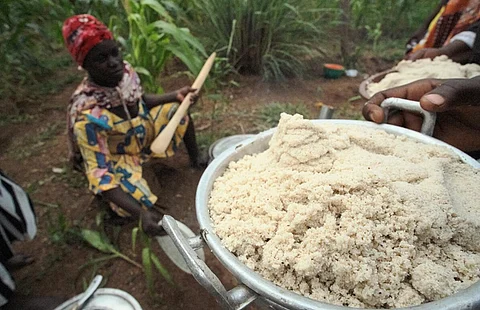

The year 2023 was declared by the United Nations as the ‘International Year of Millets’. This helped shift the focus and start meaningful dialogue on these grains known for being tolerant to climate change. One such millet is now gaining considerable attention: Fonio.
A millet from West Africa, Fonio has a vocal proponent in chef Fatmata Binta, who escaped Sierra Leone at the height of its civil war for Guinea and is now settled in Ghana.
Binta, who belongs to the Fulani tribe, the largest nomadic tribe in Arica, swears by fonio which is easy to cultivate, can withstand climate shocks and also provides sustenance as a staple food to millions of rural households in conflict-ridden and hunger-prone areas of Africa.
In India, small-grained millets like the sikiya and the raishan, are similar to fonio. All of them belong to the Digitaria species but are not widely cultivated. In fact, the cultivation of sikiya, has reduced in Dindori district of Madhya Pradesh in central India. It is the favourite millet of the Baiga tribe, an indigenous community. However, unlike the sikiya which is being forgotten, fonio has grabbed attention outside its home.
Independent American researcher Don Osborn agreed that fonio has garnered press coverage and is popular among high profile people. Fonio has been rediscovered in Europe and North America, he told this reporter.
Osborn first got to know about fonio in West Africa four decades back. “The idea that it might someday become an internationally traded and trending grain seemed far-fetched at the time. So, it is amazing how things have changed.”
He has fonio in his kitchen in Michigan.
However, Osborn’s personal impression is that this success, while remarkable, is still somewhat limited in reach. For example, fonio is not carried in many grocery chains, and most Americans know little or nothing about it, he added.
But chefs tell success stories. One of the most prominent advocates of fonio, apart from Binta, is award-winning cookbook author Pierre Thiam, a Senegalese born chef, who now resides in California. His company Yolélé is the most viewed brand on fonio. Yolélé distributes African food products across the United States. It has also introduced fonio from the drought-prone Sahel region of West Africa.
Thiam’s innovative cooking style, at once modern and eclectic, is rooted in the rich culinary traditions of West Africa. His critically acclaimed restaurant Teranga, located in Harlem, New York, offers healthy fast casual fare sourced from farmers in West Africa.
“My motivation was to propose a model of development for smallholder farmers in West Africa who have been growing this miracle grain for thousands of years but have no access to market,” Thiam, who has cooked for the King of Morocco, French President Emmanuel Macron and Former UN Secretary General Ban Ki Moon, said.
According to Thiam, as fonio is versatile, it can be used as a substitute for most grains in any recipe. It can be served as a side, a salad, a porridge, pasta, or baked into bread.
“Today’s chefs are opinion leaders and can influence their audience through various platforms. I have dedicated one of my cookbooks to the journey of fonio to better educate people about it,” Thiam added.
The chef has won many awards and accolades for his cooking and advocacy, which includes The James Beard Foundation Cookbook Hall of Fame 2024 Awards.
As a crop, fonio has been traditionally cultivated by women in northern Ghana, especially in the district of Chereponi. Millets are mainly considered women’s crops. An important fonio farmer is Christabel Kwasi, who found that it was easy to feed nutritious food to her children by cultivating fonio. As a versatile crop which can be grown without fertilisers, fonio can be consumed after being boiled or made into porridge. It can also be made into flour.
A project implemented by the Food and Agriculture Organization of the United Nations, in collaboration with Chef Binta, has given fonio farmers the reliable knowledge that they can rely on this crop throughout the year. With Ghana’s Ministry of Food and Agriculture backing the project, women farmers are enhancing their cultivation skills, boosting productivity and also household income. Kwasi can now cultivate fonio even during the dry season.
As the Fulani are a nomadic pastoral tribe, the community prefers foods available in arid and semi-arid environments. This is the reason for the love for fonio. According to chef Binta, the first African to receive the Basque Culinary World Prize in 2022, fonio has potential as it requires less water and can be grown in poor soils. Her journey with fonio started after her escape to Ghana when she found that other grains failed to sustain communities.
Like millet processing in India, which is mainly carried out by women using traditional methods and implements, the method of fonio processing is also the biggest challenge for African women. It requires pounding the grain by hand for threshing and winnowing. Then it is manually dried.
So, apart from popularising fonio recipes, Chef Binta is providing processing machines and training to women on how to operate the machinery. This will minimise an otherwise time-consuming and labour-intensive process. Women fonio producers will be able to process fonio in greater quantity while ensuring quality.
Millets are essentially grown and nurtured by women. This reporter found that in Odisha’s Koraput, millets carefully stored in houses help women exchange the grains for dried fish and vegetables through an age-old barter system still in vogue. In the state’s Niyamgiri hills, the dominance of pineapples for profit has pushed millets aside. This has changed the local dietary pattern.
In a way, millets give women a say in households.